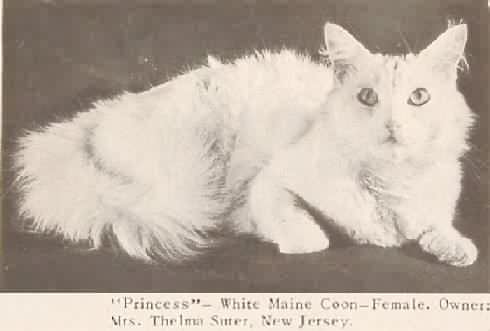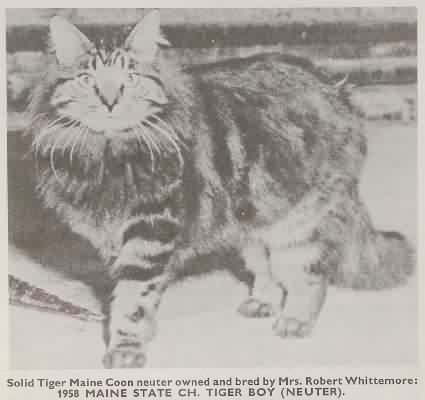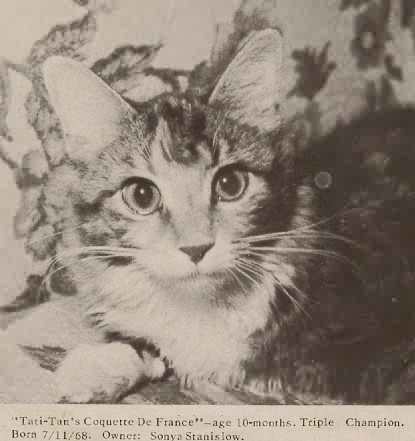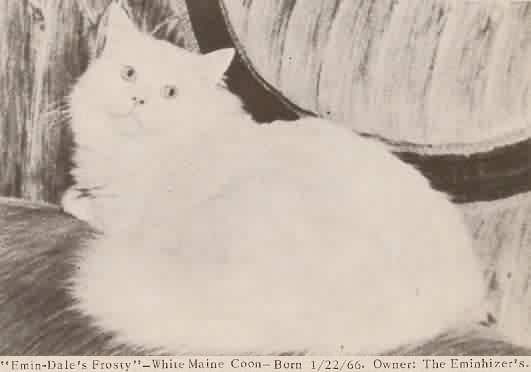| CATS magazine, Volume 26, No. 7, July 1969, pages 10 – 11
Jane S. Martinke |

Princess
THE MAINE COON Cat is one of our oldest breeds but, because it was for so long confined to one small section of the country and there was no official recognition by any association, this favorite of generations of cat lovers is virtually unknown to the world at large. I have been surprised to find that even knowledgeable and sophisticated members of the cat fancy, if they have heard of the breed at all, are inclined to consider it apocryphal. Perhaps now is the time to take a good hard look at this delightful cat.
The origins of the Maine Coons are open to surmise only, and probably always will be. One of the more common of the old wives’ tales about them is that they resulted from the mating of the Domestic Shorthair with the native American bobcat. This would be a biological impossibility and is only slightly less absurd than another story one hears that the original cross was between the Domestic Shorthair and the raccoon. At least the bobcat theory keeps it all in the feline family.
At the other end of the scale is the much more likely theory that the old seafaring captains of New England, encountering in their travels longhaired cats outside their previous experience, brought them home as interesting curiosities, much as they brought back chinoiserie and Persian shawls and rugs to adorn their homes and delight their womenfolk. It is believed that these then interbred with local domestic cats and the longhairs were sufficiently dominant to establish their characteristics in a new breed.

Tiger Boy
(1958)
There are any number of guesses lying between these two. Perhaps you would prefer the romantic legend that Marie Antoinette sent six of her cats over to a hideout in Maine and the Maine Coons are descended from them. You may take your choice or develop theories of your own, for there is none to say you nay with any real degree of authority.
The one certainty about the Maine Coon is that this is a true American breed. Since the so-called American Shorthair has its counterpart in most parts of the world, characterizing them as “American” may be open to challenge, and the new hybrid breeds which have been developed solely within the boundaries of this country have been saddled with exotic oriental names which deny their origins. Thus it may be that the Maine Coons are our only true American cat which has evolved without man’s planned interference. With typical New England forthrightness they have been given a name which actually identifies them with some degree of accuracy.
Originally these cats were certainly limited to New England, possibly even to the Maine coastline, but later they were bought up in job lots and shipped to other parts of the country, particularly to the Middle Atlantic States, for sale in pet shops where they were usually represented as being “Angoras.” Probably this carried more snob appeal to the generations in which our wealthy classes vied with each other in obtaining titled husbands for their daughters and foreignness in itself carried some cachet.
To this day many people will stoutly maintain that there are so Angora cats and that they come in all colors, although in Turkey where breeders are now working under official aegis to preserve the genuine Angora native to that country, they more modestly claim white as the only color.
There may even be a grain of truth buried somewhere in this claim that these cats were Angoras, for who knows but what the original longhaired imports may have been Angoras. This might account for the fact that they frequently come in white or have a white pattern on another ground color. On the other hand we could as easily decide that their forebears were the now unknown Russian longhairs which once flourished on the continent and the British Isles, since those were tabbies and a large percentage of the Maine Coons is tabby in whole or in part. It could even have been a mixture of the two. One can only conjecture.

Tati-tan’s Coquette de France, * jul 1968, hier 10 maanden
Many of the kittens which were shipped hither and yon were quite variegated in color with no two exactly alike and a surprising number of them were one form or another of tortoiseshells or tortoiseshells with white – cream, blue and white; cream tabby, blue tabby and white; brown tabby, red tabby and white; brown tabby with red spots now designated “Torbies;” etc. (Even today one of the standards being used specifies that white trim around chin, lip line, muzzle and upper lip is allowed in all colors.) From this we can surmise that most of the males were disposed of locally, being held in high esteem, and that it was usually the females which were available for this type of shipment and resale to satisfy the yearnings for longhaired kittens at an inexpensive price. Cruel as this type of disposal often was, it probably saved many females from drowning – the more usual fate of unwanted kittens.
Apparently misunderstanding the word “Tortoiseshell,” one pet shop in Western Pennsylvania which dealt widely in these kittens, bringing them in several dozen at a time, would advertise each new shipment received as “Turquoise Kittens for Sale.” Even now breeders in that area are apt to get requests for this color as early impressions and ideas die hard and those who saw these advertisements are convinced that there was such a color. (I myself have even had a request for a “Blue-Green Persian.”)
Some years ago there were efforts to establish Maine Coons as a true breed and some attempt at a standard for them was made, but interest in the project soon flagged. At that time “Semi-Coons” were also taken into consideration. Recently the enterprise has been reactivated and there are now dedicated and enthusiastic people working seriously and constructively with the Maine Coons for eventual fancywide recognition. They have already succeeded in having them recognized by ACA, ACFA, CCA and ICF for full championship status. It is our understanding that they are accepted at least for registration to establish foundation lines in other associations. In CFF they may be shown as AOV and in UCF as BNC, their class for pure-bred cats not yet re3cognized for championship. In the other associations they may be shown only in the household pet classes.

Emin-Dale’s Frosty, * jan 1966
Fortunately those now working with this breed with such vigor are taking a realistic and practical approach to the matter of record-keeping in full recognition of its indispensability, and they are prepared to conduct their breeding activities according to sound genetic principles in order to stabilize the breed.
There are still problems to be ironed out. For instance, I have been furnished three separate proposed standards. There may be others. Obviously it would be in the best interest of the breed if all the breeders working with it would come to an agreement on a common standard.
More of a problem, some of these cats are polydactyls. Many people admire any cat with so-called “mitten paws,” and it may well be that this characteristic has been introduced deliberately into these cats and sufficiently widely that it would be difficult to eradicate it completely. It might be even more difficult to convince the people taking stands either for or against mitten paws that they might be wrong.
In one sense this must be considered a deformity since it is a deviation from what we are accustomed to thinking of as normal feline structure. Whether it is a harmless structural deviation which does no harm to the cats’ comfort and welfare or whether it is an undesirable characteristic which should not be tolerated in any breed is something which should be included in the final standard adopted for the breed. Even if the decision is in favor of permitting polydactylism, there would remain the question of whether it should be on a permissive basis or whether it would be preferable to have two separate classes, one for normal-footed Maine Coons and one for the polydactyl Maine Coons. This is a decision which should be approached with caution as it could establish precedents and have repercussions in other breeds, especially the Domestic Shorthairs in which this trait often occurs.Maine Coons are ideal cats for household pets. They are sturdy, steady in temperament, intelligent, gentle with children and fastidious in their habits. Since they are the exact antithesis of the Persians, being long of face, long of ears, long of neck, long of body and long of legs, not to mention tail, they are apt to appeal greatly to the many people who prefer a longhaired cat but who are repulsed by the extreme cobbiness and very short nose of the Persian. Even the fur of the Maine Coon is different, as it is long and silky, tending to “flow” down rather than stand out from the nbody. It is less doublecoated than the Persian and for this reason is somewhat easier to groom and keep knotfree. The ears, which are large and prominent, usually carry long tufts of hair at the tips similar to those of a lynx.
Those who have had Maine Coons in their households consider them the complete pet with which no other breed can compare for charm, dignity and grace. This is a breed in which New Englanders have always taken pride and with reason. Now the rest of the country is going to have a chance to learn to know this truly American cat, our Yankee from Down East.

